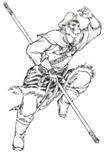Four students are talking about the best museums they have ever been to.
| Jenny The Metropolitan Museum of Art in New York City, which was built in 1872, is very popular in the world. It is one of the world's finest art museums. I really enjoyed my trip because I love modern arts very much. I think the Dance Class by Edgar Degas is the greatest work of art there. |
| Sandy Built in 1204, the Louvre Museum in Paris is the world's largest art museum. Nearly 38,000 objects from prehistory to the 21st century are exhibited there. It was great to enjoy so many treasures at one time there. Among them, I think the Mona Lisa is a must-see. |
| John First built in 1912, the National Museum of China in Beijing shows well the cultural aspects of China. Since I'm crazy about Chinese culture and history, I really enjoyed this trip. It has a large collection of bronze vessels (青铜器). My favorite one is "Hou Mu Wu" Bronze Ding. |
| Sam Built in 1753, the British Museum in London is the greatest museum I've ever been to. I enjoyed my trip there because I'm very interested in the culture of ancient Egypt. That's why I was deeply attracted by the famous Rosetta Stone (罗塞塔石碑). |
1.Where is the Metropolitan Museum of Art?
A.In New York City. B.In London. C.In Beijing. D.In Paris.
2.When was the Louvre Museum built?
A.In 1753 B.In 1204. C.In 1912. D.In 1872.
3.Which collection belongs to the National Museum of China?
A.The Dance Class. B.The Mona Lisa.
C.The Rosetta Stone. D."Hou Mu Wu" Bronze Ding.
4.Why does Sam think the British Museum is the best one?
A.Because he is crazy about modem arts.
B.Because he loves objects from prehistory.
C.Because he takes interest in Chinese culture.
D.Because he's interested in the culture of ancient Egypt.







